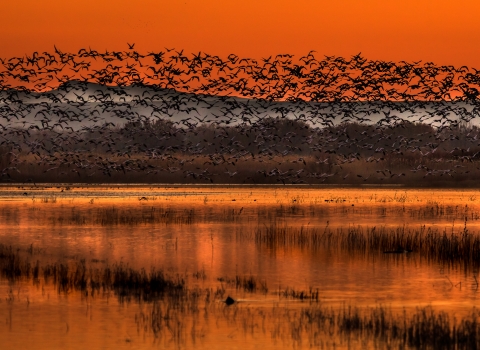Spring migration continues to roll along as upwards of 3 billion birds make their way north toward their summertime breeding grounds. Wave after wave sweeps through the Pacific Northwest, giving us all a calming seasonal spectacle that brings with it a bit of normalcy during these uncertain times. And if you’ve been following along with our #MigrationMondays content, we hope that you’ve been enjoying paying closer attention to this incredible spring migration event as it happens in real time.
Maybe you’ve already taken that next step in helping birds along the way by planting native plants and avoiding harmful pesticides, or begun building birdhouses for birds that will spend the summer in your yard. If you are seeing positive results from your efforts, congratulations - we are stoked!
Here’s another thing you can do to help birds along their way - simply take time out of your day to watch birds and take note of your observations. In addition to the benefit to your well-being that this “pause” from the world provides, birdwatching benefits birds too. By noting what you see and submitting those observations to a database such as eBird, you are expanding our knowledge about where birds go, how they get there and what they need along the way.
Birding 101
“Hold on,” you might be saying. Maybe you are new to birding and wondering how to get started. Perhaps you’ve been an appreciator of birds for a while, but are uncertain about how to take the next step into birding as an activity. Check out this infographic that we hope you will find useful as you get started.
For more on the subject from a Service bird biologist and certified “Bird Nerd,” check out this piece written back when we were celebrating the 100th anniversary of the Migratory Bird Treaty Act, a landmark agreement that laid the foundation for bird conservation as we know it today.
Why It Matters
As you begin to bird and get more comfortable with the activity, your observations will make a difference. By noting what types, how many and where you are seeing birds and submitting that data to a database such as eBird, you are contributing to a remarkable global knowledge-base. Here’s what the eBird team has to say about how your and thousands of other birders’ observations make a difference for birds:
eBird transforms a global birding community’s passion for birds into critical data for research, conservation, and education. Half a billion bird observations have been contributed so far. When combined and analyzed appropriately, these data enable next generation species distribution models that provide full life cycle information about birds at relatively fine scales across broad spatial and temporal extents. These model results inform novel conservation actions, from site-specific information about the occurrence and abundance of birds, to looking at patterns of species abundance across continent-spanning flyways.
Answers to large-scale questions such as “Where do birds go and how far do they travel?” to specific ones like “where do birds stop along the way so we can prioritize conservation of those locations?” come from citizen science data that you and many others submit. Indeed, the data you collect about birds you count from your yard, local park or National Wildlife Refuge goes a long way towards their conservation.
Now that you know more about this hobby and its impact, we hope you feel more comfortable taking the next step towards discovering an exciting way of experiencing nature. With that, we wish you happy birding!









